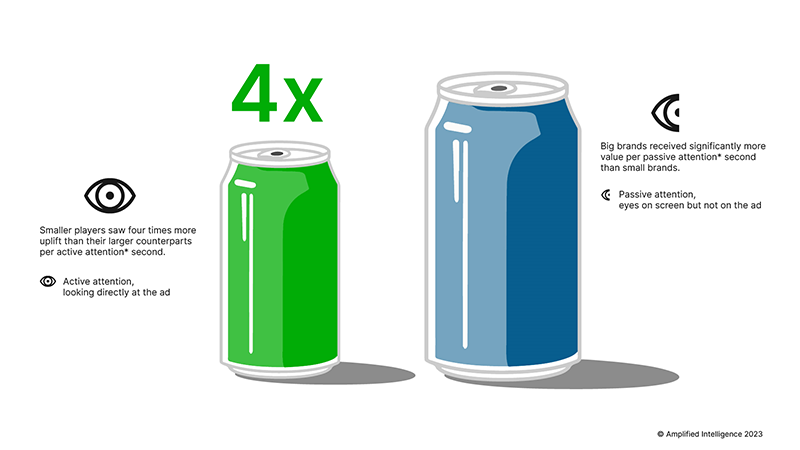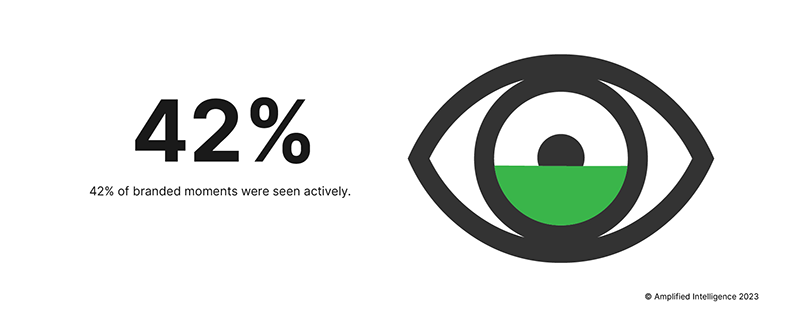In her latest WARC column, Professor Karen Nelson-Field, Founder and CEO, Amplified Intelligence, shares research that underscores the importance of understanding the nuances of attention. The study, in partnership with a leading soft drinks firm found that tailoring attention strategies based on brand size can help achieve optimal business results and campaign success.
In my last article, I noted that as the attention economy matures, and attention-centric metrics form a key fixture of media planning and buying, the industry is seeing an increase in the kind of ‘Meaty Proof’ that quantifies the link between activities and business effects – the very results CEOs aim for. After all, the ultimate objective of advertising is to achieve outcomes, whether they are at the upper, middle, or lower funnel levels. However, it's crucial to understand that the relationship between attention and outcomes is more complex than it may initially seem. This research aims to shed light on some of the reasons behind this complexity.
Although outcomes are the obvious end destination, there is a risk that focusing too heavily on the outcome will mean that how a viewer got there is missed, along with insights into the factors that affected the outcome in the first place – and this is important as this research shows. The reality is that taking final outcomes and attempting to use them as the principle basis for predicting attention simply doesn’t work. The direction of the relationship is wrong because outcome-centric insights don’t account for the variability of viewer engagement or multiple other factors that influence outcomes. This means that outcomes-based attention metrics will work sometimes, but not others. To illustrate this, I’m sharing another real-world use case.
Amplified Intelligence recently partnered with a leading soft drinks company to look beyond simply assessing ‘which media works best’ and dig into the finer details that have implications for its whole advertising approach, particularly exploring how current market share and brand placement affect campaign outcomes.
The study conducted a comprehensive analysis by gathering data from over 1,000 individuals and analyzing more than 2,300 ads. Its primary objective was to delve into various facets of attention both focus and time, including active, passive, and non-attention. The study employed a sub-second level of granularity through Amplified's advanced AI technology, including smart eye-tracking and facial detection, across various media platforms in real time.
To check the validity of the 1,000-person panel data, we built a substantial logistic regression model with 41,801 additional human observations spanning 41 product categories and 2,155 unique brands. This additional model, constructed from data previously collected all around the world, enabled us to rigorously consider interaction effects on outcomes – including brand presence, brand size (i.e. market share) and audience demographics. It widened the findings from a single brand ‘once-off’ to a more generalisable and reliably predictable outcome. For those interested, accuracy assessments include Cross-Validation (CV) Accuracy at 0.705 +/- 0.002 and Test Dataset Accuracy at 0.707.
These were our three key takeaways:
Takeaway #1: Passive and active attention work differently for different sized brands
While overall active attention plays a bigger role in brand choice than passive attention, the size of the brand mediates the value of each.
Both small and large brands experience increases in brand choice for each second of active and passive attention, (which also talks to the value of attention duration), however, the study revealed that smaller brands can achieve four times more brand uplift per second of active attention compared to their larger counterparts. So big brands benefit more per passive attention second, meanwhile small brands gain more value from each active attention second they achieve. This difference is likely due to the established mental availability of larger brands and the strength of distinctive assets in their creative.

Takeaway #2: Eyes-on-brand attention is vital to outcomes
The study also found that the likelihood of consumers "choosing" a brand was influenced significantly by the amount of human attention directed at the branded moment itself (i.e. logo, branded asset). The concept of "eyes-on-brand" attention emerged as a crucial metric in driving outcomes and refers to the precise moment the brand is present AND a viewer is actively viewing.
Although the soft drink brand performed relatively well in terms of branding quality – with the frequency and entry timing of branding better than typical creative, across all ads in the study – only 42% of these branded moments were actively viewed. Making matters worse, on ‘fast attention-decay’ platforms – where most viewers lose interest early and avoid/scroll/skip the ad fast – only 35% of participants actively viewed the 42% of the branded moments. This dual impact affects both the frequency of brand exposure and the size of the audience reached, both of which impact outcomes.

Our findings showed that while the chance of ‘choosing’ a brand is not related to any one single factor, eyes-on-ad attention is one of the most significant. These findings also highlight it's not just the duration of attention that matters, but how individuals view the content and how many (we call this attention time, attention decay and attention focus).
Takeaway #3: Outcomes cannot predict attention accurately
This work proves the vital nature of the branded moment being seen and the influence of the size of the brand in achieving an immediate outcome. A consequence of this work shows that these factors introduce bias and can skew a model trying to predict attention because the direction of the relationship is wrong. Attention can predict outcomes, but outcomes can’t predict attention. If a big brand can achieve the same amount or probability of attention but achieve fewer outcomes than a small brand how can outcomes predict attention? If a poorly branded ad can achieve the same amount or probability of attention but achieve fewer outcomes than a well branded ad how can outcomes predict attention? This is the nuance of interaction effects.
Conclusion
The research emphasizes the importance of nuanced insight into attention, beyond mere duration, and how it influences outcomes. It also underscores the importance of considering brand size and the challenges associated with achieving full immersion during branded moments. For our partner, the study came as the first step in a long-term plan to adopt attention-led metrics that help pinpoint how real audiences interact with ads and lead to outcomes, and reduce reliance on imprecise proxies; with granular insight guiding more impactful campaigns.
In summary, the study underscores the importance of understanding the nuances of attention and tailoring attention strategies based on brand size to achieve optimal business results and campaign success.

